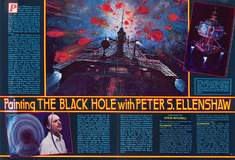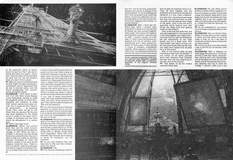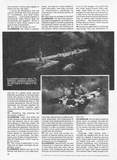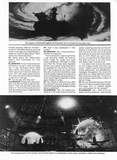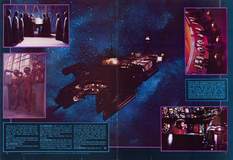Peter Ellenshaw's career has spanned 45 years of active motion picture work in England and the U.S., has included more than 50 films for several major producers and is now culminating in his work as production designer and director of special effects for The Black Hole. Ellenshaw learned his trade as assistant matte artist on such great Alexander Korda epics as Things to Come, The Thief of Bagdad, Rembrandt and Victoria the Great. In 1948, Walt Disney went to England to begin production of his live-action features Treasure Island, The Story of Robin Hood, Sword and the Rose and Rob Rot. To recreate a long-gone England. Disney chose Ellenshaw. About the same time Disney began planning production of Jules Verne's science fiction classic, 20,000 Leagues Under the Sea, he brought Ellenshaw to the Disney Studio in Hollywood. Ellenshaw followed production progress on the underwater epic and in his spare time made skteches of how he visualized Nemo's submarine Nautilus. Walt Disney's habit was to walk through his studio after hours, examining his artists' work, what ideas they had rejected, what they doodled. It was a complete surprise to Ellenshaw one morning at a 20,000 Leagues production conference when Disney told the head of special effects, "Take a look at Peter's stuff. I think he has some good ideas here." Ellenshaw's (Inceptions of a backlit submarine were included, and he went on to supervise the matte shots and miniature work that helped win an Academy Award for Special Effects in 1954. Soon after came Darby O'Gill and the Little People (directors Steven Spielberg and John Landis have said they feel it is the finest example of perspective special effects ever made). Ellenshaw planned and designed Darby to be shot without process photography on one gigantic set which required so much light to maintain depth of field, that the Burbank utilities lost a substation when the power was turned on without warning. In 1964, Peter Ellenshaw received his own Oscar for work on Disney's Mary Poppins. The film is an amazing amalgamation of animation, live-action, and optical and mechanical special effects. In between these Disney motion pictures, he managed time in 1960 to paint mattes for Stanley Kubrick's Spartacus. Ellenshaw considered retirement in 1973 and returned to his home in Ireland, having finished production design for Disney's Island at the Top of the World. But Disney producer Winston Hibler had an idea for an outer space movie he wanted to make and asked Ellenshaw to come back. When Hibler died in 1975, the idea was carried on by producer Ron Miller. Ellenshaw closed his house in Ireland and returned to Hollywood. His imagination is now a driving force behind The Black Hole.
[…]
